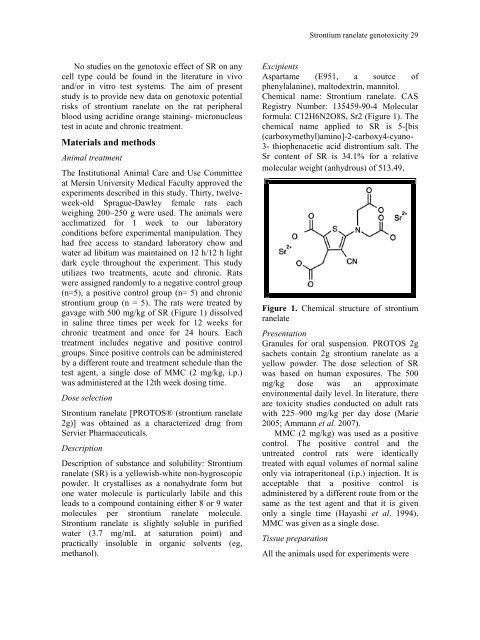Journal of Cell and Molecular Biology - ResearchGate
Journal of Cell and Molecular Biology - ResearchGate
Journal of Cell and Molecular Biology - ResearchGate
You also want an ePaper? Increase the reach of your titles
YUMPU automatically turns print PDFs into web optimized ePapers that Google loves.
No studies on the genotoxic effect <strong>of</strong> SR on any<br />
cell type could be found in the literature in vivo<br />
<strong>and</strong>/or in vitro test systems. The aim <strong>of</strong> present<br />
study is to provide new data on genotoxic potential<br />
risks <strong>of</strong> strontium ranelate on the rat peripheral<br />
blood using acridine orange staining- micronucleus<br />
test in acute <strong>and</strong> chronic treatment.<br />
Materials <strong>and</strong> methods<br />
Animal treatment<br />
The Institutional Animal Care <strong>and</strong> Use Committee<br />
at Mersin University Medical Faculty approved the<br />
experiments described in this study. Thirty, twelveweek-old<br />
Sprague-Dawley female rats each<br />
weighing 200–250 g were used. The animals were<br />
acclimatized for 1 week to our laboratory<br />
conditions before experimental manipulation. They<br />
had free access to st<strong>and</strong>ard laboratory chow <strong>and</strong><br />
water ad libitum was maintained on 12 h/12 h light<br />
dark cycle throughout the experiment. This study<br />
utilizes two treatments, acute <strong>and</strong> chronic. Rats<br />
were assigned r<strong>and</strong>omly to a negative control group<br />
(n=5), a positive control group (n= 5) <strong>and</strong> chronic<br />
strontium group (n = 5). The rats were treated by<br />
gavage with 500 mg/kg <strong>of</strong> SR (Figure 1) dissolved<br />
in saline three times per week for 12 weeks for<br />
chronic treatment <strong>and</strong> once for 24 hours. Each<br />
treatment includes negative <strong>and</strong> positive control<br />
groups. Since positive controls can be administered<br />
by a different route <strong>and</strong> treatment schedule than the<br />
test agent, a single dose <strong>of</strong> MMC (2 mg/kg, i.p.)<br />
was administered at the 12th week dosing time.<br />
Dose selection<br />
Strontium ranelate [PROTOS® (strontium ranelate<br />
2g)] was obtained as a characterized drug from<br />
Servier Pharmaceuticals.<br />
Description<br />
Description <strong>of</strong> substance <strong>and</strong> solubility: Strontium<br />
ranelate (SR) is a yellowish-white non-hygroscopic<br />
powder. It crystallises as a nonahydrate form but<br />
one water molecule is particularly labile <strong>and</strong> this<br />
leads to a compound containing either 8 or 9 water<br />
molecules per strontium ranelate molecule.<br />
Strontium ranelate is slightly soluble in purified<br />
water (3.7 mg/mL at saturation point) <strong>and</strong><br />
practically insoluble in organic solvents (eg,<br />
methanol).<br />
Strontium ranelate genotoxicity 29<br />
Excipients<br />
Aspartame (E951, a source <strong>of</strong><br />
phenylalanine), maltodextrin, mannitol.<br />
Chemical name: Strontium ranelate. CAS<br />
Registry Number: 135459-90-4 <strong>Molecular</strong><br />
formula: C12H6N2O8S, Sr2 (Figure 1). The<br />
chemical name applied to SR is 5-[bis<br />
(carboxymethyl)amino]-2-carboxy4-cyano-<br />
3- thiophenacetic acid distrontium salt. The<br />
Sr content <strong>of</strong> SR is 34.1% for a relative<br />
molecular weight (anhydrous) <strong>of</strong> 513.49.<br />
Figure 1. Chemical structure <strong>of</strong> strontium<br />
ranelate<br />
Presentation<br />
Granules for oral suspension. PROTOS 2g<br />
sachets contain 2g strontium ranelate as a<br />
yellow powder. The dose selection <strong>of</strong> SR<br />
was based on human exposures. The 500<br />
mg/kg dose was an approximate<br />
environmental daily level. In literature, there<br />
are toxicity studies conducted on adult rats<br />
with 225–900 mg/kg per day dose (Marie<br />
2005; Ammann et al. 2007).<br />
MMC (2 mg/kg) was used as a positive<br />
control. The positive control <strong>and</strong> the<br />
untreated control rats were identically<br />
treated with equal volumes <strong>of</strong> normal saline<br />
only via intraperitoneal (i.p.) injection. It is<br />
acceptable that a positive control is<br />
administered by a different route from or the<br />
same as the test agent <strong>and</strong> that it is given<br />
only a single time (Hayashi et al. 1994).<br />
MMC was given as a single dose.<br />
Tissue preparation<br />
All the animals used for experiments were

















